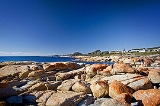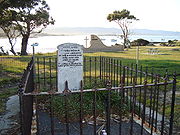
Bicheno, Tasmania
Encyclopedia
Bicheno is a town on the east coast of Tasmania
, Australia
, 185 km north-east of Hobart
on the Tasman Highway
, with a population of 640. It is part of the municipality of Glamorgan/Spring Bay
. The town is primarily a fishing
port and a beach resort
.
The town was named after James Ebenezer Bicheno
, the British Colonial Secretary for Van Diemen's Land
1843–51.
The first historical reference to the place that was to become Bicheno was made by James Kelly during his circumnavigation of Van Diemen's Land. He landed here (when it was known as Waubs Harbour) to dry his provisions. From 1803 Waubs Harbour was used as a whaling port. Bicheno was proclaimed a township in 1866.
 Near the tennis courts is the grave of Wauba Debar
Near the tennis courts is the grave of Wauba Debar
(after whom Waub's Harbour was named), an aboriginal who was stolen from her tribe as a teenager to become a "sealer's woman". Her bravery in rescuing two sealers in a storm is commemorated by a headstone.
The hinterland was established for farming in the mid-1840s and continues today. Coal was discovered in 1848. In 1854 the harbour was expanded to provide port facilities for the coal mines at Denison River. The coal was transported to the port via a 5‑km horse-drawn tramway.
 The use of Bicheno as a coal port was short-lived. The discovery of gold in Victoria saw most of the residents depart in 1855 and for nearly a century Bicheno became a sleepy little fishing village. Fishing has continued to be the lifeblood of the town with substantial quantities of crayfish
The use of Bicheno as a coal port was short-lived. The discovery of gold in Victoria saw most of the residents depart in 1855 and for nearly a century Bicheno became a sleepy little fishing village. Fishing has continued to be the lifeblood of the town with substantial quantities of crayfish
, abalone
, scallop
s and trevally
. In recent times it has become a popular tourist destination, with a range of accommodation, craft shops, two small aquaria, and a visitor centre. Visitors are also attracted to the Little Penguin
colony on adjacent Diamond Island
.
In September 2003 a memorial to the Merchant navy was unveiled in Bicheno. Five months later, in February 2004, the town presented a freedom of entry charter to the Australian Merchant Navy, the first time any locality in the world has granted 'freedom of the city' to the merchant Navy. Local primary school children have been appointed custodians of this memorial, built near Wauba Debar's grave.
Tasmania
Tasmania is an Australian island and state. It is south of the continent, separated by Bass Strait. The state includes the island of Tasmania—the 26th largest island in the world—and the surrounding islands. The state has a population of 507,626 , of whom almost half reside in the greater Hobart...
, Australia
Australia
Australia , officially the Commonwealth of Australia, is a country in the Southern Hemisphere comprising the mainland of the Australian continent, the island of Tasmania, and numerous smaller islands in the Indian and Pacific Oceans. It is the world's sixth-largest country by total area...
, 185 km north-east of Hobart
Hobart
Hobart is the state capital and most populous city of the Australian island state of Tasmania. Founded in 1804 as a penal colony,Hobart is Australia's second oldest capital city after Sydney. In 2009, the city had a greater area population of approximately 212,019. A resident of Hobart is known as...
on the Tasman Highway
Tasman Highway
The Tasman Highway is a highway in Tasmania, Australia. Like the Midland Highway, it connects the major cities of Hobart and Launceston — however it takes a different route, via the north-eastern and eastern coasts of the state. The Highway also acts as a major commuter road to Hobart...
, with a population of 640. It is part of the municipality of Glamorgan/Spring Bay
Glamorgan/Spring Bay
The Glamorgan Spring Bay Council or Municipality of Glamorgan Spring Bay covers the southern east coast of Tasmania, Australia. It includes the towns of Swansea, Orford, Triabunna and Coles Bay, as well as the national parks at Maria Island and the Freycinet Peninsula.The council gets its name from...
. The town is primarily a fishing
Fishing
Fishing is the activity of trying to catch wild fish. Fish are normally caught in the wild. Techniques for catching fish include hand gathering, spearing, netting, angling and trapping....
port and a beach resort
Resort
A resort is a place used for relaxation or recreation, attracting visitors for holidays or vacations. Resorts are places, towns or sometimes commercial establishment operated by a single company....
.
The town was named after James Ebenezer Bicheno
James Ebenezer Bicheno
James Ebenezer Bicheno was a British author and colonial official.Bicheno was the son of the Rev. James Bicheno, minister of the Baptist Church in Newbury, Berkshire. He was called to the bar in 1822 but seems to have spent most of his time until 1832 in writing and natural history pursuits,...
, the British Colonial Secretary for Van Diemen's Land
Van Diemen's Land
Van Diemen's Land was the original name used by most Europeans for the island of Tasmania, now part of Australia. The Dutch explorer Abel Tasman was the first European to land on the shores of Tasmania...
1843–51.
The first historical reference to the place that was to become Bicheno was made by James Kelly during his circumnavigation of Van Diemen's Land. He landed here (when it was known as Waubs Harbour) to dry his provisions. From 1803 Waubs Harbour was used as a whaling port. Bicheno was proclaimed a township in 1866.

Wauba Debar
Wauba Debar was a female Tasmanian aborigine. Her grave is a historic site located in the east coast Tasmanian town of Bicheno, which memorialises her rescue of two sealers, one of them her husband, when their ship was wrecked about 1 km from shore during a storm...
(after whom Waub's Harbour was named), an aboriginal who was stolen from her tribe as a teenager to become a "sealer's woman". Her bravery in rescuing two sealers in a storm is commemorated by a headstone.
The hinterland was established for farming in the mid-1840s and continues today. Coal was discovered in 1848. In 1854 the harbour was expanded to provide port facilities for the coal mines at Denison River. The coal was transported to the port via a 5‑km horse-drawn tramway.

Crayfish
Crayfish, crawfish, or crawdads – members of the superfamilies Astacoidea and Parastacoidea – are freshwater crustaceans resembling small lobsters, to which they are related...
, abalone
Abalone
Abalone , from aulón, are small to very large-sized edible sea snails, marine gastropod molluscs in the family Haliotidae and the genus Haliotis...
, scallop
Scallop
A scallop is a marine bivalve mollusk of the family Pectinidae. Scallops are a cosmopolitan family, found in all of the world's oceans. Many scallops are highly prized as a food source...
s and trevally
Carangidae
Carangidae is a family of fish which includes the jacks, pompanos, jack mackerels, and scads.They are marine fish found in the Atlantic, Indian and Pacific Oceans...
. In recent times it has become a popular tourist destination, with a range of accommodation, craft shops, two small aquaria, and a visitor centre. Visitors are also attracted to the Little Penguin
Little Penguin
The Little Penguin is the smallest species of penguin. The penguin, which usually grows to an average of in height and in length , is found on the coastlines of southern Australia and New Zealand, with possible records from Chile.Apart from Little Penguins, they have several common names...
colony on adjacent Diamond Island
Diamond Island (Tasmania)
Diamond Island is a low granite island, with an area of 6.76 ha, in south-eastern Australia. It is part of the Schouten Island Group, lying close to the eastern coast of Tasmania near the Freycinet Peninsula, just off the town of Bicheno. It is sometimes connected to the mainland by a sand spit...
.
In September 2003 a memorial to the Merchant navy was unveiled in Bicheno. Five months later, in February 2004, the town presented a freedom of entry charter to the Australian Merchant Navy, the first time any locality in the world has granted 'freedom of the city' to the merchant Navy. Local primary school children have been appointed custodians of this memorial, built near Wauba Debar's grave.

